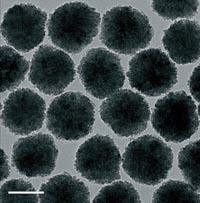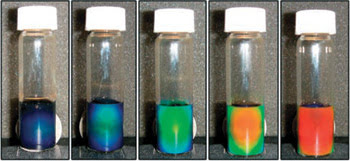
Superparamagnetic Nanoclusters Form Photonic Crystals
Crystal structure and diffraction are controlled by magnetic field.
Lauren I. Rugani
Photonic crystals hold promise in optoelectronic applications that require the manipulation of photons, as in telecommunication devices and sensors. Although a desirable photonic crystal will have a tunable stop band controllable by external stimuli, most devices are limited by small tunability, slow response to external stimuli or difficult integration into an existing photonic system.

A TEM image shows the colloidal nanoclusters, made up of smaller magnetite particles. Scale bar 100 nm. Images reprinted with permission of Angewandte Chemie.
Now, researchers at the University of California, Riverside, have reported using superparamagnetic colloidal nanoclusters for constructing photonic crystals that overcome these challenges.
Made up of smaller 10-nm magnetite crystals, polyacrylate-capped Fe3O4 nanoclusters are grown uniformly by reacting Fe3+ cations with NaOH. The size of the nanoclusters can be tuned between 30 and 180 nm by adjusting the amount of NaOH added to the reaction. Because of the highly charged surfaces and the superparamagnetic properties retained by the primary crystals, the nanoclusters align automatically into ordered arrays only in the presence of a magnetic field.
Depending on the size of the nanoclusters and the strength of the applied magnetic field, diffracted ambient light by the photonic crystal will display peaks across the visible spectrum. Clusters between 160 and 180 nm primarily diffract red light in a weak magnetic field because the crystal structure becomes unstable in stronger fields. Smaller clusters form ordered structures only under strong magnetic fields, and they diffract blue light. Although various applications require different working wavelengths, researcher Yadong Yin said that medium-size clusters — 120 to 130 nm — might work best because they diffract light across the entire visible spectrum.
As an NdFeB magnet is moved from 3.7 to 2.0 cm away from a sample containing 120-nm clusters, the strength of the magnetic field increases from 87.8 to 352 G. Accordingly, the interplanar spacing decreases from 274 to 169 nm, and the peak diffraction blueshifts from 730 to below 450 nm, demonstrating the full range of tunability of the nanoclusters. This response also is reversible, as the diffraction experiences a redshift when the magnet is moved back, away from the sample.

Images of the colloidal crystals demonstrate the blueshift in diffraction peaks as the distance between the magnet and the sample decreases (right to left).
Besides a wide tunable range and reversibility, the photonic crystals exhibit a rapid optical response during the introduction or removal of an external magnetic field. Using an Ocean Optics Inc. spectrometer coupled to a six-around-one reflection probe, the researchers measured the reflectance spectra from the photonic crystal in the presence of a periodically switched magnetic field. Most applications require the precise control of optical responses through defined external stimuli, Yin noted.
Ordered structures form within 200 ms after the magnetic field is turned on, and the diffraction peaks disappear completely 100 to 200 ms after the magnetic field is turned off. While the field is on, there is no gradual diffraction wavelength development; however, the clusters continue to arrange themselves, leading to a gradual increase in diffraction intensity.
With tunability and response time challenges met, the next step to incorporating the device into practical applications will be the miniaturization of the systems to the microscale.
“We can use the external magnetic field to individually control the color of each small volume so that they can be used as chemical and biosensors, highly integrated optical switches and flexible color displays,” Yin said. He and his team will look into all the possible applications for this technology but will focus on developing sensing devices and color display units.
Angewandte Chemie, published online July 3, 2007, doi: 10.1002/ange.200701992.
Published: September 2007